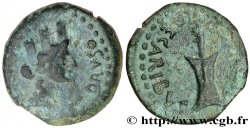brm_1046314 - TIBERIO Denier
200.00 €
Cantidad
Añadir a su cesta

Tipo : Denier
Fecha: c. 15-22
Nombre del taller / ciudad: Lyon
Metal: plata
Milésimas de pureza : 950 ‰
Diámetro: 18 mm
Eje de acuñación: 11 h.
Peso: 3,45 g.
Comentarios sobre el estado de conservación:
Monnaie centrée, fourrée. Joli revers. Patine grise, tachée
N° en los catálogos de referencia :
Anverso
Titulatura del anverso: TI CAESAR DIVI - AVG F AVGVSTVS.
Descripción del anverso: Tête laurée de Tibère à droite (O*).
Traducción del anverso: “Tiberius Cæsar Divi Augusti Filius Augustus”, (Tibère César fils du divin Auguste, auguste).
Reverso
Titulatura del reverso: PONTIF - MAXIM.
Descripción del reverso: Pax (la Paix) ou Livie assise à droite sur un siège décoré, tenant une branche d'olivier de la main gauche et de la droite un long sceptre.
Traducción del reverso: “Pontifex Maximus”, (Grand pontife).
Comentario
Monnaie fourrée. Faux d’époque. Comme pour le denier d'Auguste, cette pièce appartient à l'atelier impérial de Lyon et ce type de denier a circulé pendant pratiquement un siècle. Il se rencontre très souvent avec des monnaies gauloises de la phase terminale dans les fouilles archéologiques. C’est la monnaie romaine la plus courante en Gaule pour les Julio-Claudiens. La première émission se caractérise par un socle représenté par deux lignes et les pieds du siège sont droits au revers.
Filled coin. Period fake. As with the denarius of Augustus, this coin belongs to the imperial workshop of Lyon and this type of denarius circulated for almost a century. It is very often found with Gallic coins from the final phase in archaeological excavations. It is the most common Roman coin in Gaul for the Julio-Claudians. The first issue is characterized by a base represented by two lines and the feet of the seat are straight on the reverse
Filled coin. Period fake. As with the denarius of Augustus, this coin belongs to the imperial workshop of Lyon and this type of denarius circulated for almost a century. It is very often found with Gallic coins from the final phase in archaeological excavations. It is the most common Roman coin in Gaul for the Julio-Claudians. The first issue is characterized by a base represented by two lines and the feet of the seat are straight on the reverse








 Informar de un error
Informar de un error Imprimir la página
Imprimir la página Comparte mi selección
Comparte mi selección Haz una pregunta
Haz una pregunta Consignar / vender
Consignar / vender
 Descriptivo
Descriptivo











